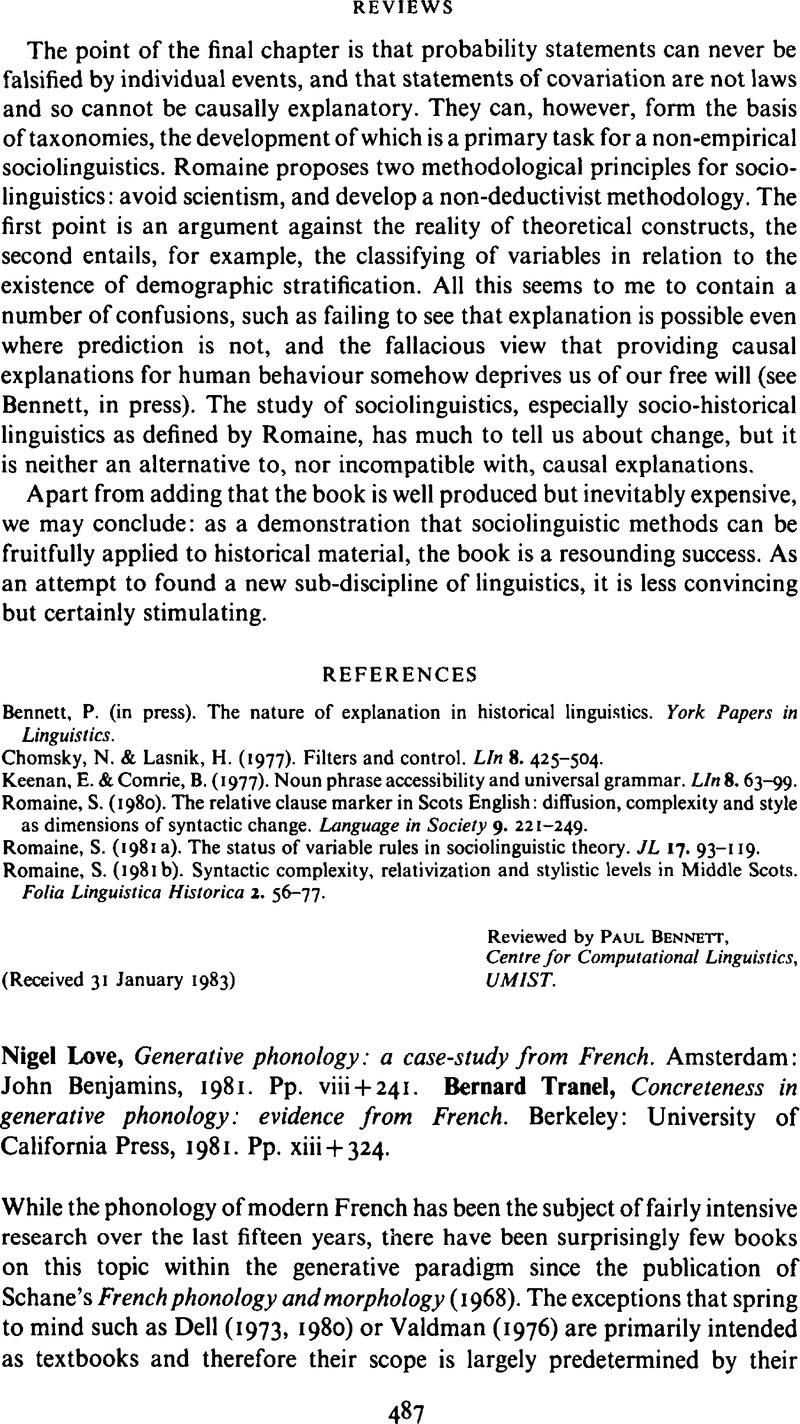No CrossRef data available.
Article contents
Nigel Love, Generative phonology: a case-study from French. Amsterdam: John Benjamins, 1981. Pp. viii + 241. - Bernard Tranel, Concreteness in generative phonology: evidence from French. Berkeley: University of California Press, 1981. Pp. xii + 324.
Published online by Cambridge University Press: 28 November 2008
Abstract
An abstract is not available for this content so a preview has been provided. Please use the Get access link above for information on how to access this content.

- Type
- Reviews
- Information
- Copyright
- Copyright © Cambridge University Press 1983
References
REFERENCES
Anderson, S. R. (1982). The analysis of French schwa; or, how to get something for nothing. Lg 58. 534–573.Google Scholar
Dell, F. (1973). Les règles et les sons. Paris: Hermann. translated as Generative phonology and French phonology Cambridge: Cambridge University Press, 1980.Google Scholar
Dummett, M. (1982). Linguistics demythologised. Review of Harris' The language myth. London Review of Books, 19 08 to 2 09.Google Scholar
Durand, J. (1982). Review of Foley, Theoretical morphology of the French verb. JL 18. 474–477.Google Scholar
Foley, J. (1979). Theoretical morphology of the French verb. Amsterdam: Benjamins.CrossRefGoogle Scholar
Klausenburger, J. (1974). Rule inversion, opacity, conspiracies: French liaison and elision. Lingua 34, 167–179.CrossRefGoogle Scholar
Klausenburger, J. (1977). Deletion vs. epenthesis: intra- vs. inter-paradigmatic arguments in linguistics. Lingua 42. 153–160.CrossRefGoogle Scholar
Klausenburger, J. (1978a). Liaison 1977: The case for epenthesis. Studies in French Linguistics 1: 2. 1–20.Google Scholar
Klausenburger, J. (1978b). French linking phenomena: A natural generative analysis. Lg 54. 21–40.Google Scholar
Klausenburger, J. (1978c). Mikolaj Kruszewski's theory of morphophonology. Historiographia Linguistica: v: 1/2. 109–120.Google Scholar
Long, M. (1978). Discussion of Klausenburger's paper. Studies in French Linguistics 1: 2. 21–26.Google Scholar
Love, N. (1977). The generative phonological analysis of non-vocalic alternations in modern French. D.Phil. thesis, University of Oxford.Google Scholar
Schane, S. A. (1972). Natural rules in phonology. In Stockwell, R. P. & Macaulay, R. P. S. (eds), Linguistic change and generative theory. Bloomington: University of Indiana Press. 199–229.Google Scholar
Schane, S. A. (1974). There is no French truncation rule. In Campbell, R. J. et al. (eds), Linguistic studies in Romance languages. Washington: Georgetown University Press. 89–99.Google Scholar
Tranel, B. (1974). The phonology of nasal vowels in modern French. Ph.D. dissertation, University of California, San Diego.Google Scholar
Tranel, B. (1976). A note on final consonant deletion in modern French. Lingua 39. 53–68.CrossRefGoogle Scholar
Valdman, A. (1976). Introduction to French phonology and morphology. Rowley, Mass: Newbury House.Google Scholar


